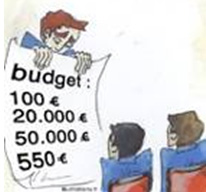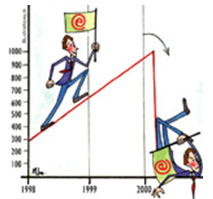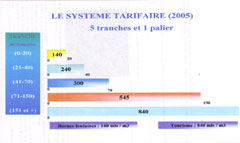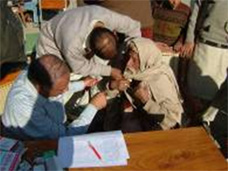1) What is involved?
Two types of very distinct pricing although they both implement all of the very different parameters and likewise with their objectives :
- "mixed" pricing which provides the normal financing for the service but also its extension for underprivileged households.
- "two-part" pricing, comprised of a fixed element intended in principle to further amortise the cost of the facilities by the small consumers (the subscription) and of a variable element according to the volume consumed.
This pricing is however unfair and can end up being disastrous for the poorest in the event the subscription has a high price. One must therefore know how to correct this.
2) Who use this means and since when?
"Mixed" pricing is especially used by communities or States, and rather rarely elsewhere, who prefer to implement, rather than individual assistance paid to the users with low incomes, collective solutions in the form of financing hydraulic infrastructures that facilitate their access to water or sanitation.
"Two-part" pricing has been in widespread use for a long time now but does not have any social goal at all. While making it possible to finance certain equipment that is useful for all and to balance the budget for the services, it is also used, but without saying so, by certain communities to reduce the apparent price per m3 printed on the bills, with the latter concerning only the volumes consumed.
3) Why?
See above.
4) What does this method involve? How is it used?
a) "Mixed" social pricing
 Principle
Principle
This does not provide any direct advantage, but only a collective one, to low-income users.
The principle consists in increasing the price of water, either for the entire population, or in a more targeted manner for the highest consumers or for the inhabitants of neighbourhoods considered to be well-off, in such a way as to form a Financing fund in order to finance for example, either the creation or the extension of a network, or the installation of new public fountains in the poor sections of town.
This is therefore in fact a balanced pricing thanks to grants referred to as "crossed" between diverse categories of the population, intended not to reduce the price per m3 for the poorest immediately, but only later once the equipment has been installed, or to facilitate access for them to water or to sanitation.
This pricing, which can also be applied to progressive pricing methods for a community, are also sometimes applied to the level of a State through the application of a national tax on the price of water intended to supply the Assistance or investment funds.
Achievement examples
 - In France, a national tax for example has existed for a long time now on the price per m3, intended to feed into the FNAER, a national assistance fund for the supply of water in rural areas, which was not specifically intended to facilitate access to water for the poorest but does this indirectly in the country.
- In France, a national tax for example has existed for a long time now on the price per m3, intended to feed into the FNAER, a national assistance fund for the supply of water in rural areas, which was not specifically intended to facilitate access to water for the poorest but does this indirectly in the country.
- In Ivory Coast, the government created a "Water development fund" supplied by a high tax on the invoices (40%). The latter was officially intended to subsidise connections to the network, in particular for underprivileged families.
Unfortunately, it has ignored the poorest sections of town or shantytowns in certain cities, as unauthorised residential zones are not eligible, and has not allowed many families to connect due to the cost which is too high and which furthermore is abruptly increased after the connection despite the subsidy which is offered.
So such initiatives are interesting but can be more easily followed at the level of a town than a country.
Main advantages
- Formula allowing investment for the future
- Facilitates interesting solidarity of course, but in reality creates constraints, between the various categories of a population.
- Has a more collective rather than individual nature, is easier to manage and makes it possible to then procure water inexpensively, and even free of charge if for example access to the public fountains is free, for entire populations of certain sections of town.
Main disadvantages
- Difficulty sometimes in getting the principle accepted and in striking a good balance between those who must pay more for their water and those who obtain it thanks to them but by paying a lower price or nothing at all.
- Risk of a lack of interest for the middle classes to connect if for example there are many public fountains with an advantageous price in the vicinity.
- Results are not as immediate and sometimes take a long time to manifest.
- Risk of a deviation of the initially-announced objective as the project progresses, especially on a national level, and therefore requires special monitoring.
b) Two-part pricing
Preliminary comment : This is presented here only for the purposes of demonstrating the negative incidences that it can have on certain categories of users, and more especially on those who have little income, and above all in order to indicate the means for adjusting it for more equity and solidarity.
Mode de pricing :
 This includes 2 elements :
This includes 2 elements :
- a fixed portion (such as what often exists for electricity and the telephone) called a "subscription" and which is therefore invariable regardless of consumption, which is supposed to cover a portion of the exceptional investment costs, the rental of meters and subscription management costs
- a variable portion equal to multiplying the number of m3 consumed by the price of this m3.
The actual total average price of the water is therefore higher the lower the consumption is.
With low consumption and a high fixed portion, the amount of the subscription can even exceed the price of the m3 consumed…
Examples :
 - In Barcelona pricing, which is of the progressive type, includes 3 brackets : €0.45 /m3 up to 72 m3, then €0.91/ m3 up to 144 m3 and €1.36/m3, as well as a fixed portion of €60/year.
- In Barcelona pricing, which is of the progressive type, includes 3 brackets : €0.45 /m3 up to 72 m3, then €0.91/ m3 up to 144 m3 and €1.36/m3, as well as a fixed portion of €60/year.
This high amount for the subscription corresponds in fact to that for 102 m3 consumed. We see that in sum, the actual price to pay for these 102 m3, is not €60 but €120, which is €1.18 due to the fixed portion. Likewise, for an average standard consumption of 120 m3, the fixed portion represents 44% of the bill. This percentage decreases as consumption rises.
- Other examples :
Let’s suppose that in a community the price for the variable portion is €2/m3 and that the fixed portion amounts to €90/year.
A person who consumes only 50 m3/year will in fact pay for his water at an average price per m3 of €3.80 which is 38% more expensive than if he had consumed 120 m3/year, the standard consumption (which is €2.75/m3). The same would practically apply (+ 35%) if the price per m3 was only €1.50 and that of the subscription at €60/year, but the phenomenon would be even more accentuated (+ 56%) if the fixed portion were €120 or if consumption were less.
Other cases with French towns which however are not seaside : In Bordeaux, the fixed portion is €64. In Lyon it is €67. In Grasse, it even reaches €102. In Wallonia (Belgium), the fixed portion is €87
Principle of improvement to be made to this pricing :
The amount of the fixed portion of the rate (the subscription) is substantially reduced, and even suppressed, at least for people with low income or who are vulnerable.
Lacking this, as many mayors do not agree with this, towns must manage measures for accompanying these populations (social assistance, grants or introduction of socio-economic parameters into the pricing) so that at least those with low income are not underprivileged.
Ways of offsetting the corresponding loss of income
These can either be of a tax nature, and it is then the tax income of the town (General budget) which fills in the difference, or of a rate nature. In this case, specialists recommend various types of solutions such as :
 - Moderately reducing the fixed portion in a first step in order to find substitution resources more easily or in a more acceptable manner.
- Moderately reducing the fixed portion in a first step in order to find substitution resources more easily or in a more acceptable manner.
- Increasing the rates for the variable portion by instituting measures for accompanying the poor.
- Switching to pricing of a progressive type, or accentuating the impact of it if it is already being implemented, which will normally have the advantage of reducing consumption.
- Reducing the fixed portion for domestic use and increase it for commercial or industrial users or for high consumption, and by not reducing it for second homes.
- Instituting a seasonal pricing that is higher in the summer when the corresponding meter readings are on a quarterly basis (rare) or possible without too much additional cost.
- Offsetting the increase of rates for families who are truly large through specific assistance systems.
- Limiting or better controlling the individual use of the water tables (wells) or creating a special tax.
- Replacing the fixed portion with a tax or a specific contribution for the investment costs of the Department, which is not a lump sum but modulated according to method or type of use of the network.
Main advantages of this decrease
- Simplicity and high effectiveness possible for the system, especially when the amount of the subscription is high.
- Suppression of an often substantial source of inequality in treatment between the poor or small consumers of water and the others.
- Increased transparency in rates and in the price put forth per m3, as the latter often corresponds only to that of the variable portion and makes it possible to put forth a price that is less than the actual price paid which is often much higher.
 Main disadvantages
Main disadvantages
- Rather strong opposition from many water department organisation authorities and of their delegates that highlight the substantial portion of fixed costs in the cost of water and the need to balance the accounts or to favour large families, high consumers or companies.
- Often results in rate increases for permanent residents in particular in seaside resorts where the fixed portions are high.
- Reduction that is unfavourable for large consumers, including large families.
- Need to find new sources of income in order to offset the reductions put into place and if the latter are substantial, the price of the variable portion has to be increased.
5) Special difficulties and precautions to be taken
- Do not act too quickly. Do not focus too much on doctrine and try to make changes via amendments if they are only minor.
- Understand the real problems in the communities concerned and try to engage thought with their Mayors on the various options possible.
- Give the inhabitants at least time to understand, if there is not full approval, the reasons for the proposed modifications.
- See what could possible be the other temporary measures for accompanying the change under consideration if the latter can only be progressive.
6) Where to obtain further information
 - Académie de l’eau (The Water Academy). Publication (April 2012) of a book (100 pages) : "The fixed portion in the pricing of water for households" by Henri SMETS, President of the ADEDE and acknowledged specialist in issues with pricing water in the world. Very interesting and well documented, illustrated with many graphs and supplemented with many appendices, this book provides understanding for all of the dimensions of this often misunderstood problem and more details on the solutions that can be considered. Available online on :
- Académie de l’eau (The Water Academy). Publication (April 2012) of a book (100 pages) : "The fixed portion in the pricing of water for households" by Henri SMETS, President of the ADEDE and acknowledged specialist in issues with pricing water in the world. Very interesting and well documented, illustrated with many graphs and supplemented with many appendices, this book provides understanding for all of the dimensions of this often misunderstood problem and more details on the solutions that can be considered. Available online on :














